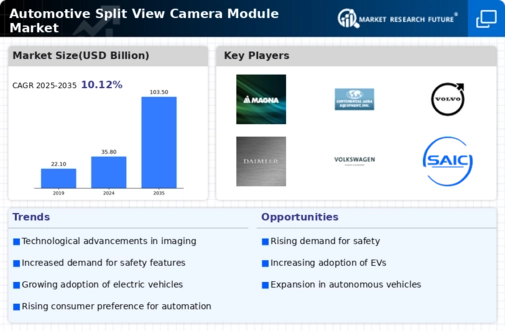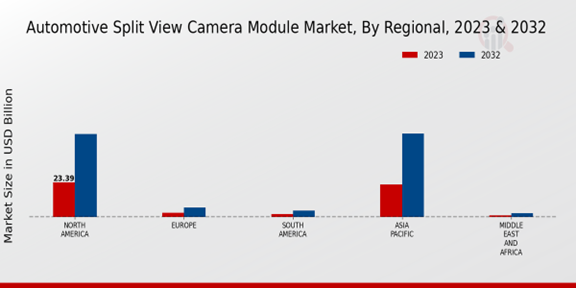Increasing Vehicle Production and Sales
The Global Automotive Split View Camera Module Market Industry is closely linked to the overall growth in vehicle production and sales. As global automotive production continues to rise, driven by emerging markets and increasing consumer demand, the need for advanced safety features, including split view camera modules, becomes more pronounced. The automotive industry is projected to witness a compound annual growth rate (CAGR) of 10.12% from 2025 to 2035, indicating a robust expansion phase. This growth is likely to stimulate investments in camera technologies, as manufacturers seek to differentiate their offerings in a competitive market.
Government Regulations and Safety Standards
Government regulations and safety standards are increasingly influencing the Global Automotive Split View Camera Module Market Industry. Many countries are implementing stricter safety requirements for vehicles, which often include the integration of advanced camera systems to enhance visibility and reduce blind spots. For example, regulations mandating rearview cameras in new vehicles have already been established in several regions. As these regulations expand globally, the demand for split view camera modules is expected to rise. This regulatory push not only promotes safety but also encourages manufacturers to innovate and improve their camera technologies to comply with evolving standards.
Technological Advancements in Camera Systems
Technological advancements play a pivotal role in shaping the Global Automotive Split View Camera Module Market Industry. Innovations in camera resolution, image processing, and sensor technology have led to enhanced performance and reliability of split view systems. For instance, the introduction of high-definition cameras and advanced algorithms for image stitching has improved the overall user experience. As these technologies evolve, they are expected to drive market growth, with projections indicating a market size of 103.5 USD Billion by 2035. This growth trajectory suggests that automotive manufacturers will increasingly incorporate sophisticated camera systems to meet consumer expectations for high-quality visual aids.
Consumer Preference for Enhanced Safety Features
Consumer preferences are shifting towards vehicles equipped with enhanced safety features, significantly impacting the Global Automotive Split View Camera Module Market Industry. As awareness of road safety increases, consumers are more inclined to choose vehicles that offer advanced visual aids, such as split view camera systems. This trend is evident in the growing popularity of SUVs and luxury vehicles, which often come equipped with these technologies as standard. The increasing consumer demand is likely to drive market growth, with projections indicating a market size of 103.5 USD Billion by 2035, highlighting the importance of safety features in purchasing decisions.
Rising Demand for Advanced Driver Assistance Systems
The Global Automotive Split View Camera Module Market Industry is experiencing a surge in demand driven by the increasing adoption of advanced driver assistance systems (ADAS). These systems enhance vehicle safety and convenience, integrating technologies such as lane departure warnings and collision avoidance. As consumers prioritize safety features, the market for split view camera modules is projected to grow significantly. By 2024, the market value is expected to reach 35.8 USD Billion, reflecting a robust interest in innovative automotive technologies. This trend suggests that manufacturers are likely to invest heavily in developing and integrating these camera systems into new vehicle models.





























Leave a Comment